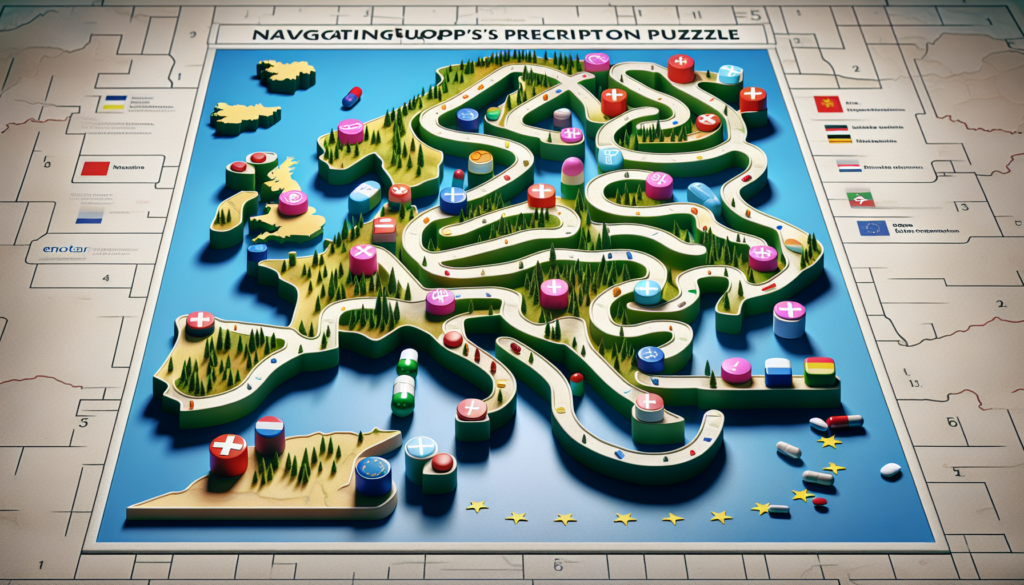Introduction to Europe’s Prescription Landscape
Europe’s healthcare system is as diverse as its rich cultural mosaic, with each country operating under distinct healthcare regulations and prescription fulfillment processes. Understanding these intricacies is crucial, particularly when dealing with cross-border prescriptions within the European Union (EU). This guide will delve into the complexities of navigating Europe’s prescription puzzle, equipping you with the necessary knowledge to manage your prescription needs across different European countries effectively. The focus keyword for this article is “Europe’s prescription landscape.”
The Basics of Cross-Border Prescriptions in the EU
European patients and healthcare providers need to understand the framework surrounding cross-border prescriptions. The EU’s Directive 2011/24/EU ensures that patients can obtain medical treatment in another EU country, including filling prescriptions. However, complexities remain, such as varying national rules and the recognition of prescriptions across borders.
Understanding Prescription Regulations Across Europe
Variations in Prescription Fulfillment
Each EU country has its unique approach to prescription fulfillment. It’s essential to be aware of these differences, as they may affect both the accessibility and cost of medication.
- Local Language Requirements: In some countries, prescriptions need to be translated into the local language to be accepted.
- Generic vs. Brand Names: The preference for generic versus brand-name drugs can vary, impacting prescription processing.
Restrictions and Limitations
Cross-border prescriptions are subject to certain restrictions, which can influence their acceptance.
- Controlled Substances: Medicines that are classified as controlled substances may require additional documentation.
- Medicine Formulations: Some formulations available in one country may not be licensed in another.
Opportunities for Patients
Despite the obstacles, navigating Europe’s prescription landscape offers significant opportunities, particularly in terms of access to a broader range of treatments and potentially lower medication costs.
Access to Specialized Treatments
Some countries may not have the necessary resources or expertise for certain specialized treatments. Patients can benefit from cross-border healthcare by accessing these treatments in other EU countries.
- Rare disease treatments available in specialized centers across Europe.
- Innovative treatments that are launched in specific EU countries first.
Cost Benefits
There can be substantial cost differences in medication prices between EU countries. Patients often discover that obtaining certain prescriptions abroad offers substantial savings.
- Comparative shopping of medicine costs across member states.
- Utilizing the EU’s price transparency to find cost-effective options.
Challenges in Navigating the Prescription Maze
While opportunities exist, challenges persist when navigating Europe’s prescription puzzle. Issues such as regulatory discrepancies, lack of cohesive electronic prescription systems, and varying national healthcare policies can create hurdles.
Regulatory Discrepancies
Each member state retains a certain degree of autonomy over its healthcare system, causing regulatory discrepancies.
- Differing rules about prescription validity periods.
- Varying standards for clinical proof and drug approval.
Electronic Prescriptions
The uneven rollout of electronic prescription systems across Europe can be a barrier to seamless prescription fulfillment.
- Diversity in electronic health record systems.
- Inconsistent interoperability between systems.
Tips for Patients Managing Cross-Border Prescriptions
To better navigate Europe’s prescription landscape, patients can utilize certain strategies.
- Pre-Travel Research: Verify prescription requirements and availability of medicines in your destination country.
- Consult Healthcare Professionals: Always seek advice from your healthcare provider before traveling.
- Documentation: Ensure you have all necessary documents, including a detailed prescription, identification, and any required translations.
Conclusion: Navigating Europe’s Prescription Puzzle
Understanding Europe’s prescription landscape is essential for those seeking medical care across European borders. While there are opportunities for accessing diverse treatments and cost savings, it’s crucial to stay informed about the varying prescription fulfillment processes and regulations. Making informed decisions and maintaining open communication with healthcare providers can ease this complex journey, ensuring that patients can navigate the prescription puzzle with confidence.
Summary
This comprehensive guide traverses the intricate landscape of Europe’s prescription regulations, highlighting the core challenges and opportunities of cross-border prescriptions within the EU. By understanding the diversities in healthcare systems, patients can leverage Europe’s rich resources for broader treatment options and potential cost benefits. Remember, this information is intended for knowledge enhancement and should not replace medical advice. Always consult with healthcare professionals before managing cross-border prescriptions.

